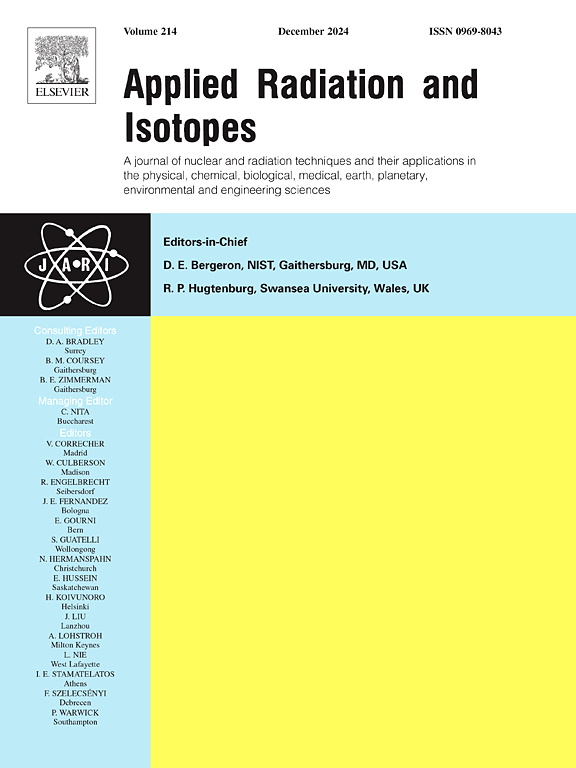Analysis of acrylamide irradiation degradation effects and products in the starch mechanism
IF 1.6
3区 工程技术
Q3 CHEMISTRY, INORGANIC & NUCLEAR
引用次数: 0
Abstract
Acrylamide (AA), a neurotoxic and potentially carcinogenic compound, forms in starch-rich foods during high-temperature processing, raising significant food safety concerns. Effective AA mitigation strategies are essential. Among degradation methods, irradiation is a promising food processing technology that reduces harmful contaminants without compromising food quality. To investigate the effect of irradiation on AA degradation and explore potential degradation mechanisms, this study first established a liquid chromatography-based detection method to detect AA in starch matrices. Starch matrices containing AA were irradiated with 60Co-γ rays, and the effects of irradiation dose, initial concentration, and moisture content on degradation efficiency were analyzed. Furthermore, high-performance liquid chromatography-quadrupole time-of-flight mass spectrometry (HPLC-Q-TOF-MS) was employed to identify degradation products and elucidate their formation pathways. Results demonstrated that liquid chromatography effectively detected AA in starch matrices. At an initial AA concentration of 1000 mg/kg and 60 % moisture content, a 2 kGy irradiation dose achieved a 99.12 % degradation rate. Total ion chromatogram analysis identified 17 degradation compounds, with five key products primarily formed through graft polymerization reactions between AA and glucose in the starch matrix. In conclusion, optimized 60Co-γ irradiation effectively degrades AA in starch-based food matrices while generating specific degradation products. These findings offer valuable insights into applying irradiation technology to reduce AA, providing an important reference for enhancing food safety control strategies.

丙烯酰胺辐照降解淀粉的效果及产物机理分析
丙烯酰胺(AA)是一种神经毒性和潜在致癌化合物,富含淀粉的食品在高温加工过程中形成,引起了重大的食品安全问题。有效的AA缓解策略至关重要。在降解方法中,辐照是一种很有前途的食品加工技术,它可以在不影响食品质量的情况下减少有害污染物。为了研究辐照对AA降解的影响并探索可能的降解机制,本研究首先建立了一种基于液相色谱的检测淀粉基质中AA的方法。采用60Co-γ射线辐照含AA淀粉基质,分析辐照剂量、初始浓度和含水率对降解效率的影响。此外,采用高效液相色谱-四极杆飞行时间质谱(HPLC-Q-TOF-MS)鉴定降解产物并阐明其形成途径。结果表明,液相色谱法可有效检测淀粉基质中的AA。在初始AA浓度为1000 mg/kg、含水率为60%的条件下,2 kGy的辐照剂量可达到99.12%的降解率。总离子色谱分析鉴定出17种降解化合物,其中5种主要通过淀粉基质中AA与葡萄糖的接枝聚合反应生成。综上所述,优化后的60Co-γ辐照能有效降解淀粉基食品基质中的AA,并产生特异性降解产物。这些研究结果为辐照技术降低AA含量提供了有价值的见解,为加强食品安全控制策略提供了重要参考。
本文章由计算机程序翻译,如有差异,请以英文原文为准。
求助全文
约1分钟内获得全文
求助全文
来源期刊

Applied Radiation and Isotopes
工程技术-核科学技术
CiteScore
3.00
自引率
12.50%
发文量
406
审稿时长
13.5 months
期刊介绍:
Applied Radiation and Isotopes provides a high quality medium for the publication of substantial, original and scientific and technological papers on the development and peaceful application of nuclear, radiation and radionuclide techniques in chemistry, physics, biochemistry, biology, medicine, security, engineering and in the earth, planetary and environmental sciences, all including dosimetry. Nuclear techniques are defined in the broadest sense and both experimental and theoretical papers are welcome. They include the development and use of α- and β-particles, X-rays and γ-rays, neutrons and other nuclear particles and radiations from all sources, including radionuclides, synchrotron sources, cyclotrons and reactors and from the natural environment.
The journal aims to publish papers with significance to an international audience, containing substantial novelty and scientific impact. The Editors reserve the rights to reject, with or without external review, papers that do not meet these criteria.
Papers dealing with radiation processing, i.e., where radiation is used to bring about a biological, chemical or physical change in a material, should be directed to our sister journal Radiation Physics and Chemistry.
 求助内容:
求助内容: 应助结果提醒方式:
应助结果提醒方式:


